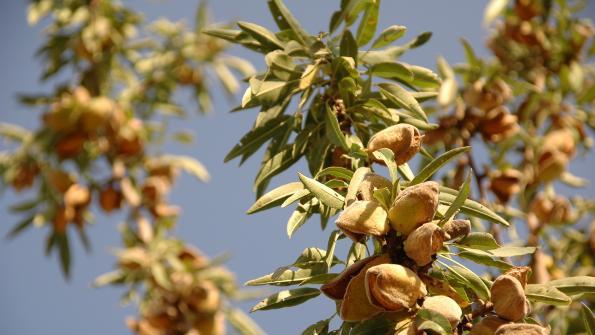November 30, 2016

Pruning and orchard sanitation practices during tree dormancy can play a major role in minimizing production costs and maximizing returns from the next year’s almond crop.
This is true only if done properly, says David Doll, University of California Cooperative Extension (UCCE) farm advisor in Merced County.
For example, Doll says pruning may or may not boost yields, depending on the age of the tree. He recommends pruning trees during the first year or two of the stand to select good scaffolds and establish the basic structure of the tree. This can reduce scaffold splitting and improve equipment access later.
However, from then on, Doll says there is no need to prune trees except to improve equipment access, protect worker safety, or remove broken or diseased limbs.
“The value of pruning young almond trees is to achieve proper structure of the tree,” he notes.
“But, keep in mind the more limbs you cut off of first- and second-leaf trees the more you are reducing yields for the next one to four years or so. Once the tree reaches maturity, pruning has little effect on almond yields.”
This input reflects the results of a long-term study by UCCE farm advisors which examined the impact of different pruning practices on production (yield) of mature almond trees.
One of the researchers - Roger Duncan, UCCE Stanislaus County farm advisor – reported in 2010 the following Nonpareil yield for that year, plus the cumulative yield through the 11th growing season of his trials.
Below is a summary of Duncan’s findings on the yield comparison of four pruning strategies on Nonpareil almond trees.
Kernel pounds/acre Kernel pounds/acre
Trained to three scaffolds and 3,203 22,388
pruned annually (conventional
pruning)
Trained to three scaffolds pruned 3,457 23,648
one more year, then unpruned
since except for equipment access
Trained to multiple scaffolds and 3,241 22,418
minimally pruned annually
(3 cuts per tree)
Only lowest limbs removed for 3,395 23,714
shaker access during first year
(no scaffold selection); essentially
unpruned except for equipment
access �
Duncan said, “Trees that had gone essentially unpruned for most of the life of the orchard were still yielding as well or better than trees than had been conventionally pruned every year.
Cumulatively, the unpruned trees yielded 1,260 to 1,326 pounds per acre more than trees pruned every year.
Doll says mature trees can be pruned from the end of harvest through February or March while young trees can be pruned from after harvest full leaf expansion in the spring without affecting tree growth.
Winter sanitation
Other studies by UCCE researchers highlight the value of winter sanitation – removing mummy nuts which can provide home and food for overwintering Navel orangeworm (NOW) larvae – to minimize the threat of this pest to the next year’s crop.
NOW damage exceeding 2 percent is considered excessive. This last season, some almond growers experienced much higher levels.
“In some areas, growers really struggled with controlling NOW populations in their orchards,” Doll says. “It seems that, in some cases, growers cut back on winter sanitation to reduce costs in response to lower almond prices.”
He adds, “However, winter sanitation is the most effective strategy you can take for controlling NOW. It adds to production costs, but it’s not as expensive as high levels of NOW damage.”
The UCCE trials suggest that leaving as few as .3 mummies per tree in almond orchards in the Bakersfield, Calif., area without an insecticide treatment can result in a 1 percent level of NOW damage in the crop.
Due to slower rates of insect development resulting from fewer degree days further north, the number of mummies required for NOW damage to reach 1 percent without insecticide treatment in Merced County increases to one mummy per tree.
“If you leave an average of 10 mummies per tree in Kern County without any chemical intervention during the season, you can expect to have about 30 percent NOW damage to your crop,” Doll says.
“Leaving the same number of mummies per tree in Merced County and not applying an insecticide is likely to result in about 10 percent NOW damage.”
The almond specialist recommends removing mummies by shaking almond trees after a little rain or moisture, or if necessary, using crews with poles to knock the mummies loose. Once on the ground, sweep the mummies into the row middles and then shred them using a flail mower to kill the larvae and destroy the rotting kernels which the larvae feed on.
“We used to advise removing the mummies by March 15,” Doll says. “However, with temperatures warming earlier in the season, it is probably better to remove them by the beginning of March.”
You May Also Like




